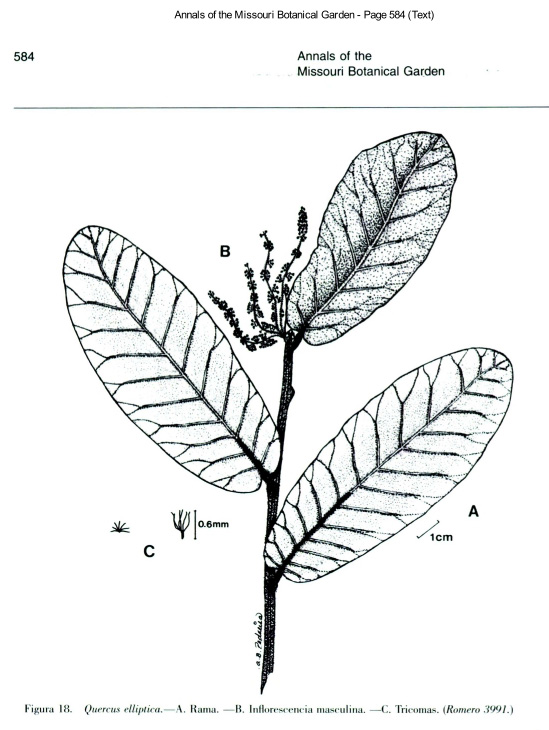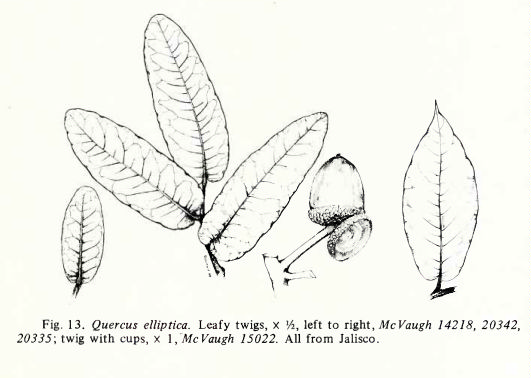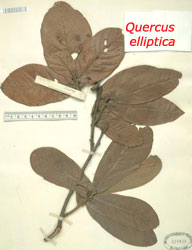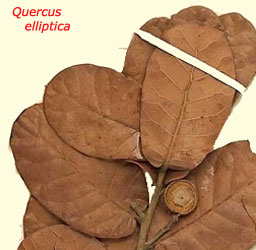| Quercus elliptica | |
| Author |
Née 1801. Anales Ci. Nat. 3: 278 Diagnosis here |
| Synonyms | atrescentirhachis Trel. (A. Camus n°
346) bothryocarpa Trel. 1924 Diagnosis here chiquihuitillonis Trel. 1924 Diagnosis here coccinata Trel. comayaguana Trel. 1930 exaristata Trel.1924 Diagnosis here guayabalana Trel. ex Standl.1930 hondurensis Trel. 1924 (A.Camus n° 333) Diagnosis here lanceolata Mart. & Gal. ex A.DC 1864 langlassei Trel. 1924 Diagnosis here linguifolia Liebm. 1854 Diagnosis here nectandrifolia Liebm. 1854 (A. Camus n° 327) Diagnosis here oajacana Liebm. 1854 Diagnosis here oaxacana Trel. 1924 peradifolia E.F.Warb. 1939 porriginosa Trel. 1924 pubinervis Mart. & Gal. 1843 salicifolia var. oajacana (Liebm.) Wenz. 1884 yoroensis Trel. 1940 yoroensis var. aguanana Trel. 1940 |
| Local names | encino
cucharita |
| Range | Mexico (Guerrero,
Jalisco, Mexico, Michoacan, Nayarit, Oaxaca, Sinaloa, Vera Cruz) ; Guatemala
; ; El Salvador ; Honduras ; 500-2400 m ; |
| Growth habit | 2-15 m high;
trunk 0.15-0.60 m in diameter; |
| Leaves | 3-12 x 2-6 cm; deciduous; leathery, hard; elliptic, lanceolate or oblanceolate; apex rounded or obtuse, sometimes acute and aristate, and sometimes emarginate; base rounded, cordate or auricled; margin entire, cartilaginous, slightly revolute, without bristles; light green, smooth and shiny above, nearly glabrous (some multiradiate, 5-7 rays, stalked trichomes mostly on vein axils); paler beneath, glabrous or with some stellate hairs along midrib, and axillary tufts; 8-16 vein pairs prominent abaxially; epidermis slightly bullate and papillose; petiole 3-7 mm, tomentose; |
| Flowers | in February-March; male catkins strongly pubescent, 5-9 cm long, with numerous flowers; pistillate inflorescences 0.7-1.5 cm, with 1-5 flowers; |
| Fruits | acorn 1.3-1.5 cm, ovoid; base truncate; singly or 2-3 together; sessile or on a 2-3 mm stalk; shallow cup enclosing only 1/3 of nut, with thin, pubescent, triangular scales; maturing in 1 year in October; |
|
Bark, twigs and |
bark dark grey, rough; twigs 2-3 mm in diameter, covered with dense stellate yellow tomentum; small lenticels, covered with the pubescence; buds 3 mm long, reddish, shiny; stipules deciduous, 4-7 mm long; |
| Hardiness zone, habitat | not hardy; well drained soils in wet montane forests; |
| Miscellaneous | -- Sub-genus Quercus, section
Lobatae, Series Erythromexicanae; -- One must not confuse Q.comayaguana Trel. with Q.comasaguana (= Q.vicentensis) ! -- Hybridizes with Q.sapotifolia ; -- Very close to Q.aristata Hook. et Arn.; -- For Gorvaerts & Frodin, Q.nectandrifolia is a separate species, but not for today's Mexican Authors (Susana Valencia-Avalos, 2004, who, moreover, makes a synonymy with Q.porriginosa and Q.elliptica). |
| Subspecies and varieties |
--- var. microcarpa A.DC 1864 |
| Pictures |
Exsiccata : botryocarpa
|





